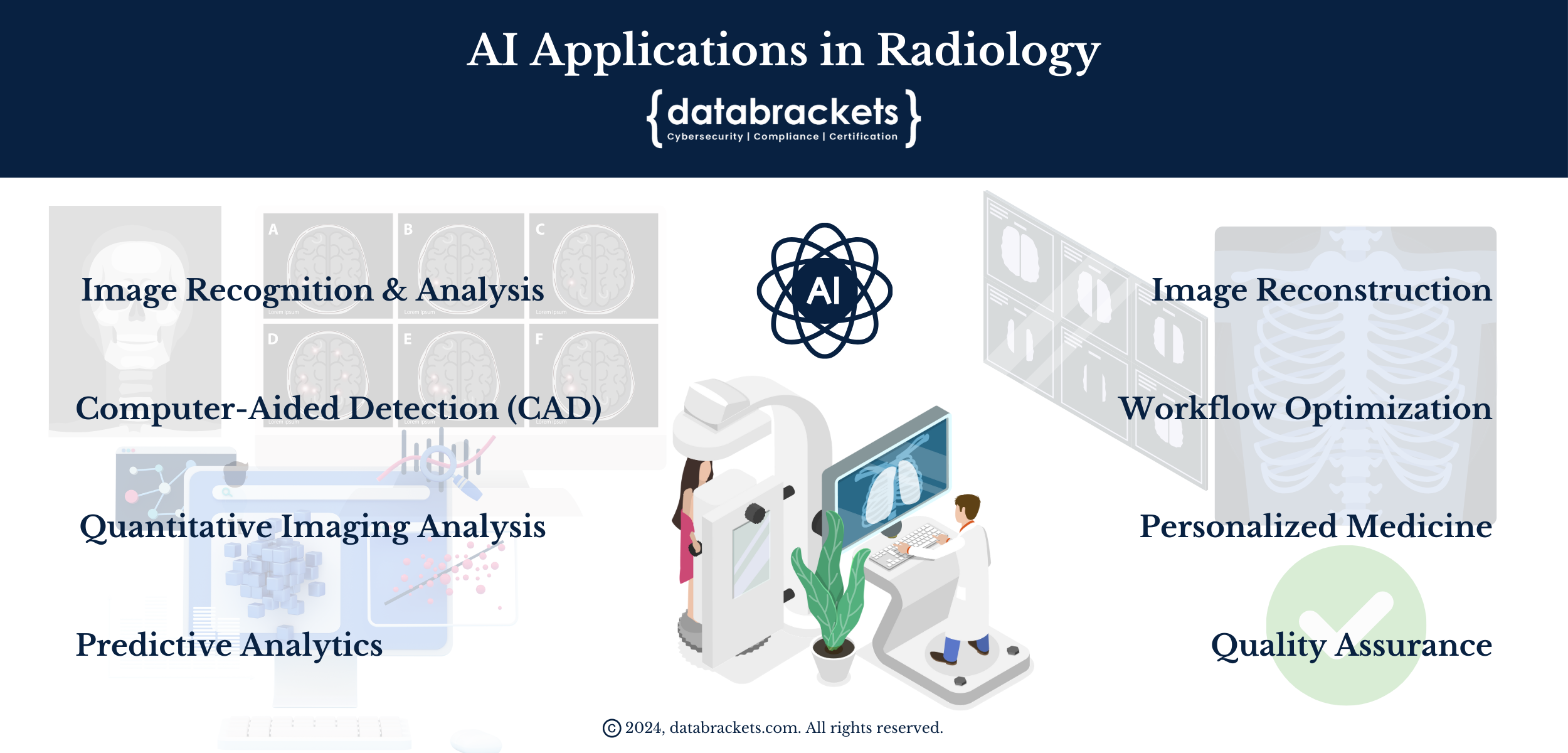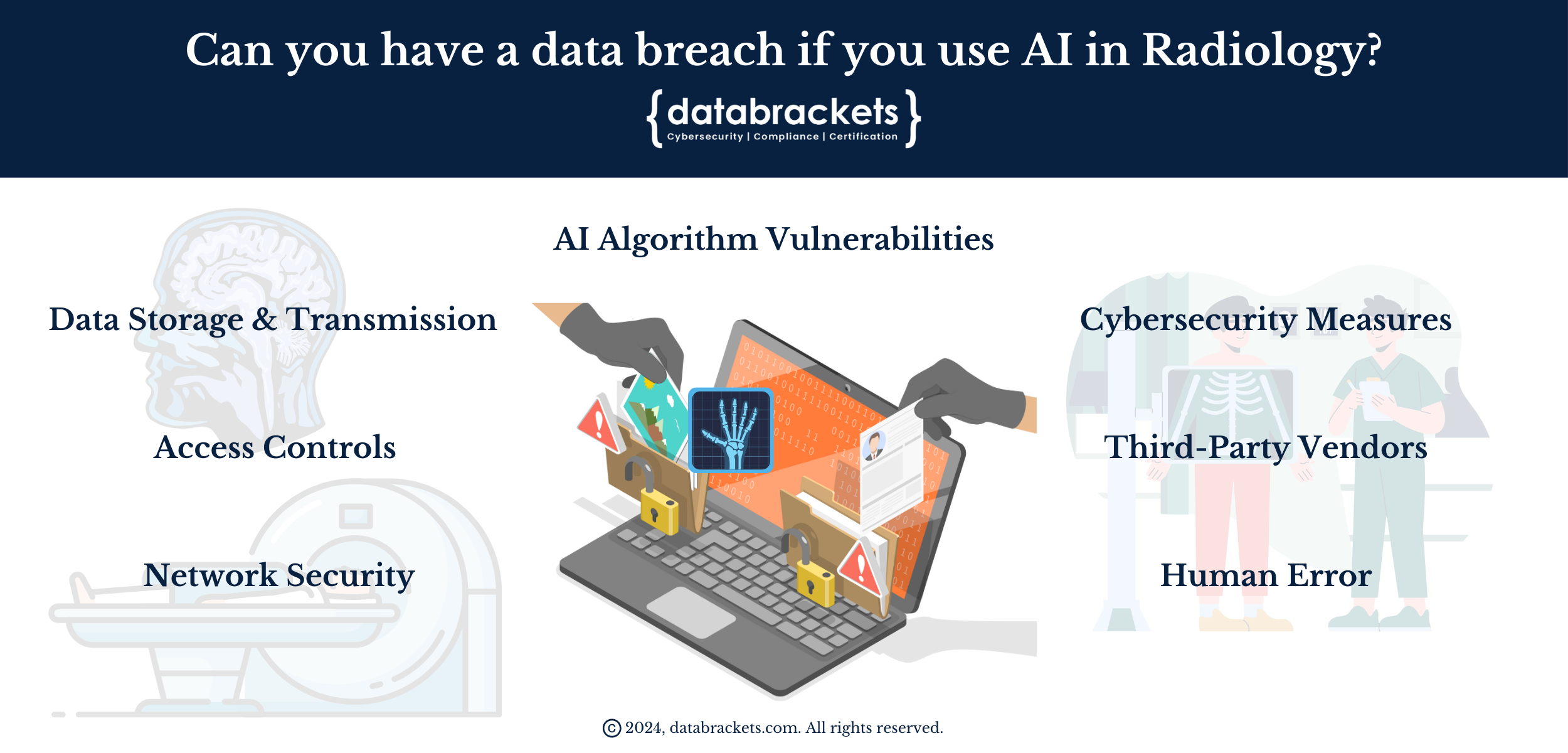As the integration of Artificial Intelligence (AI) into radiology continues to advance, it brings forth a multitude of opportunities to enhance diagnostic accuracy, streamline workflows, and improve patient outcomes. However, alongside these benefits come notable security considerations that demand careful attention. The convergence of sensitive patient data, complex algorithms, and interconnected digital systems introduces vulnerabilities that can compromise patient privacy, data integrity, and even clinical decision-making processes. Addressing these security challenges is paramount to ensure the responsible and ethical deployment of AI in radiology, safeguarding patient confidentiality, maintaining trust in healthcare systems, and upholding the integrity of medical practices. This necessitates a comprehensive understanding of the unique security risks inherent in AI-driven radiology solutions, coupled with robust strategies for encryption, access control, data anonymization, and ongoing monitoring to mitigate potential threats effectively.

AI Applications in Radiology
AI has made significant strides in radiology, revolutionizing the field by enhancing diagnostic accuracy, efficiency, and patient care. Here are several examples of AI applications in radiology:
1. Image Recognition and Analysis
AI algorithms are trained to interpret medical images such as X-rays, MRIs, and CT scans. These algorithms can identify abnormalities, tumors, fractures, and other anomalies with high accuracy. For example, AI systems can assist radiologists in detecting early signs of diseases like cancer or identifying subtle fractures in X-rays.
2. Computer-Aided Detection (CAD)
CAD systems use AI to highlight areas of interest on medical images, helping radiologists focus their attention on potential abnormalities. CAD systems have been particularly useful in mammography for detecting breast cancer. By flagging suspicious regions, CAD systems reduce oversight and enhance diagnostic accuracy.
3. Quantitative Imaging Analysis
AI algorithms can quantify various features in medical images, providing valuable quantitative data to assist in diagnosis and treatment planning. For instance, AI can measure tumor size, volume, and growth rate, aiding oncologists in assessing disease progression and response to therapy.
4. Predictive Analytics
AI models can analyze medical imaging data along with clinical and demographic information to predict patient outcomes. For example, AI algorithms can predict the likelihood of complications following surgery or the risk of disease recurrence based on imaging findings.
5. Image Reconstruction
AI techniques such as deep learning are used to reconstruct high-quality images from low-dose scans or incomplete data, reducing radiation exposure to patients while maintaining diagnostic accuracy. This is particularly beneficial in CT imaging, where radiation dose reduction is a significant concern.
6. Workflow Optimization
AI systems can streamline radiology workflows by prioritizing cases, automating repetitive tasks, and assisting with report generation. By reducing the radiologist’s workload and improving efficiency, AI helps expedite diagnosis and treatment.
7. Personalized Medicine
AI enables the development of personalized treatment plans by analyzing imaging data along with genomic and clinical information. This approach allows healthcare providers to tailor therapies to individual patients, optimizing treatment outcomes and minimizing side effects.
8. Quality Assurance
AI algorithms can analyze medical images to ensure quality and consistency, detecting artifacts, positioning errors, and other issues that may affect diagnostic accuracy. By providing real-time feedback to radiologists, AI helps maintain high standards in imaging interpretation.
Overall, AI has been transforming radiology by augmenting the capabilities of radiologists, improving diagnostic accuracy, efficiency, and patient outcomes. As technology continues to advance, AI-driven innovations will play an increasingly vital role in the field of radiology.

Can you have a data breach if you use AI in Radiology?
Yes, it is possible to have a data breach in radiology even when using AI. AI systems in radiology typically require access to large volumes of patient data, including medical images and associated patient information. If proper security measures are not in place, there can be vulnerabilities that may lead to data breaches. Here are some factors to consider:
1. Data Storage and Transmission
Radiology departments store and transmit vast amounts of patient data. If this data is not adequately protected during storage or transmission, it can be vulnerable to unauthorized access.
2. Access Controls
Access to patient data, including medical images, should be restricted to authorized personnel only. Weak access controls or compromised credentials can lead to unauthorized access and potential breaches.
3. Network Security
The networks used to transmit data between different systems and locations within a healthcare facility should be secure. Weak network security can expose data to potential breaches.
4. Cybersecurity Measures
Proper cybersecurity measures, including encryption, firewalls, intrusion detection systems, and regular security audits, are essential to protect against data breaches.
5. Third-Party Vendors
If a healthcare facility relies on third-party AI vendors for radiology solutions, it’s crucial to ensure that these vendors have robust security measures in place to protect patient data.
6. Human Error
Even with AI systems in place, human errors can still occur. For example, accidentally sharing sensitive patient information with unauthorized individuals or falling victim to social engineering attacks can lead to data breaches.
7. AI Vulnerabilities
AI models themselves can have vulnerabilities that could be exploited by malicious actors including but not limited to data leakage, adversarial prompt injection attacks, and integrity.
To minimize the risk of data breaches in radiology when using AI, healthcare facilities should have strong data security policies and procedures in place. This includes implementing encryption, access controls, employee training on cybersecurity best practices, and regular security assessments to identify and address vulnerabilities. Compliance with healthcare data privacy regulations, such as HIPAA in the United States, is also essential to protect patient data and avoid legal consequences in the event of a breach.

Security Certifications for AI Vendors in Radiology
to Prevent a Data Breach
When radiology companies consider AI vendors for their healthcare solutions, it’s important to ensure that these vendors have robust security practices in place to prevent data breaches and protect patient information. While there isn’t a specific security certificate or credential that all AI vendors must possess, there are several industry standards and certifications that can provide assurance of strong security controls. Some of these include:
ISO 27001 is an international standard for information security management systems (ISMS). Vendors that have achieved ISO 27001 certification have demonstrated a commitment to implementing and maintaining strong information security practices. It covers a broad range of security controls and is widely recognized.
2. HIPAA Compliance
If the AI vendor deals with healthcare data in the United States, compliance with the Health Insurance Portability and Accountability Act (HIPAA) is crucial. HIPAA sets strict standards for the protection of patient health information (PHI). Vendors should have HIPAA compliance programs and controls in place.
3. HITECH Act Compliance
The Health Information Technology for Economic and Clinical Health (HITECH) Act is an extension of HIPAA, and it places additional requirements on vendors handling electronic PHI (ePHI). Vendors should be aware of and adhere to HITECH Act requirements.
4. SOC 2 Compliance
Service Organization Control 2 (SOC 2) is a set of auditing standards designed for technology and cloud computing organizations. It evaluates controls related to security, availability, processing integrity, confidentiality, and privacy. A SOC 2 report can provide insights into a vendor’s security practices.
5. NIST Cybersecurity Framework
The National Institute of Standards and Technology (NIST) Cybersecurity Framework provides guidelines for improving cybersecurity practices. Vendors that follow NIST guidelines for cybersecurity can demonstrate their commitment to security.
6. GDPR Compliance
If the AI vendor operates in the European Union or handles data related to EU residents, compliance with the General Data Protection Regulation (GDPR) is essential. GDPR sets strict requirements for the protection of personal data.
7. Vendor Security Assessment
Radiology companies can conduct their own security assessments of potential AI vendors. This assessment may include a review of the vendor’s security policies, practices, and infrastructure. They can also request compliance with benchmarks in the NIST AI Risk Management Framework or ISO 42001.
8. NIST AI Risk Management Framework
With the NIST AI Risk Management Framework, Healthcare providers can effectively manage the risks associated with AI systems in radiology and ensure the safe and secure use of these technologies in their own healthcare settings and the settings of their vendors.
9. ISO 42001
While ISO 42001 isn’t tailored specifically for AI in radiology, its principles can be adapted and applied effectively to improve asset management practices within radiology organizations, ultimately leading to better service delivery, cost savings, and compliance using AI.
In addition to these certifications and standards, it’s crucial for radiology companies to engage in due diligence when selecting AI vendors. This may include reviewing the vendor’s security documentation, conducting security audits, and seeking references from other healthcare organizations that have worked with the vendor.
Ultimately, the choice of certification or standard may depend on the specific regulatory requirements in your region and the nature of the data being handled. A combination of these certifications and thorough vendor assessments can help radiology companies ensure that their AI vendors have the necessary controls in place to prevent data breaches and protect patient data.
How databrackets can help you with your AI Security and Compliance
AI security is a rapidly emerging industry where billions of data points are stored, analyzed, and transferred for processing. Hackers are staying ahead of the game, especially as the radiology industry focuses more on implementing AI solutions. databrackets, with its early mover advantage in the AI space, has worked with several clients to understand and mitigate AI risks. We continue to partner with the leaders in AI security to identify and mitigate the security and privacy risks.
Contact us to learn about our AI Security and Compliance Services:
1. AI Model vulnerability Scan: Ensure the security and reliability of your AI systems with our comprehensive AI Model Vulnerability Scan, designed to identify and mitigate potential threats.
2. AI Pen Testing: Safeguard your AI applications with our expert AI Pen Testing services, uncovering vulnerabilities and fortifying your defenses against potential cyber threats.
3. NIST AI Risk Management Framework (DIY, Hybrid or Consulting Packages) : Adopt the NIST AI Risk Management Framework to systematically identify, assess, and mitigate risks, ensuring the responsible and secure deployment of AI technologies
4. ISO 42001(DIY, Hybrid or Consulting Packages): Implement ISO 42001 to establish robust AI management systems that ensure ethical, transparent, and accountable AI operations across your organization.
databrackets overview
Our team of security experts has supported organizations across a wide variety of industries to align their processes with security frameworks like HIPAA, 21 CFR Part 11, ISO 27001:2022, SOC 2, NIST SP 800-53, NIST Cybersecurity Framework, NIST SP 800-171, GDPR, CMMC etc.
We are constantly expanding our library of assessments and services to serve organizations across industries. Schedule a Consultation if you would like to Connect with an Expert to understand how we can customize our services to meet your specific requirements.
Related Links:
Cybersecurity and Compliance Best Practices for Radiology
Benefits of Pen Testing for Radiology
Author: Aditi Salhotra, Digital Marketing and Business Development, databrackets.com
Aditi is a Digital Marketing and Business Development Professional at databrackets.com. She graduated with honors in Marketing from Sheridan College, Canada. In addition to her current profile, she contributes to Product Development and Content Creation. She is a strong advocate of Good Cyber Hygiene and white hat SEO techniques. She is proud of the company’s mission to safeguard organizations from cyber threats and ensure their business continuity in adverse situations.
Technical Expert: Srini Kolathur, Director, databrackets.com
The technical information presented in this blog has been carefully reviewed and verified by our Director, Srini Kolathur. Srini is results-driven security and compliance professional with over 20 years of experience supporting, leading, and managing global IT security, compliance, support, and risk assessment in fortune 100 companies. Some of his key areas of focus are SOC 2, ISO 27001, NIST 800-171, NIST 800-53, NIST Cybersecurity Framework, HIPAA, Security Risk Assessment, CMMC 2.0 among others. He is a CMMC Registered Practitioner (RP), CISSP, CISA, CISM, MBA. He is active in several community groups including Rotary International and TiE.